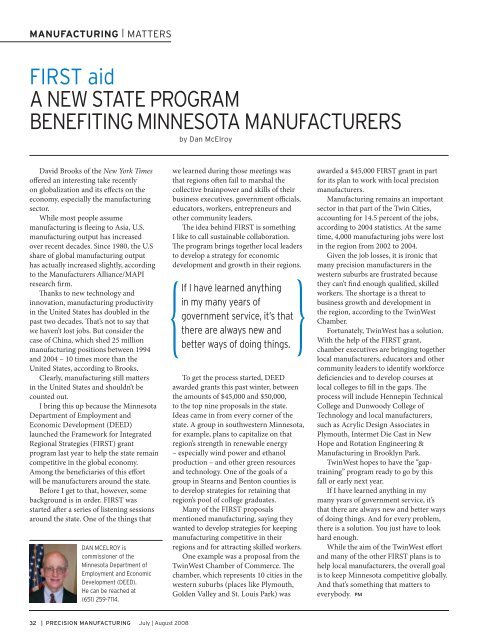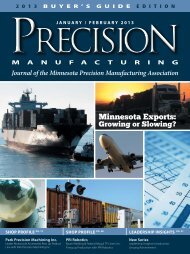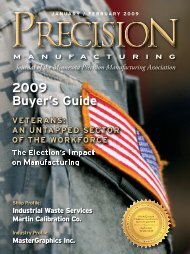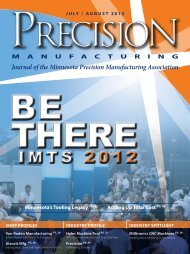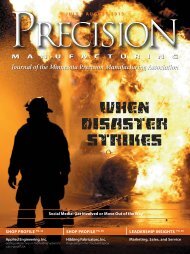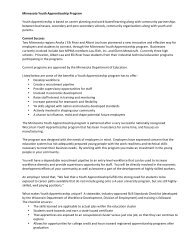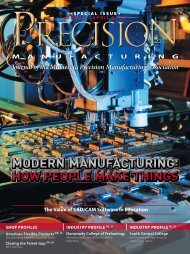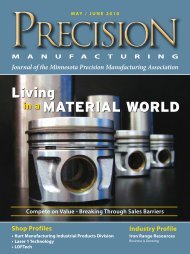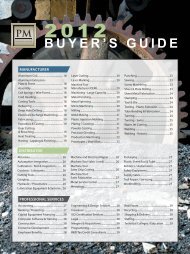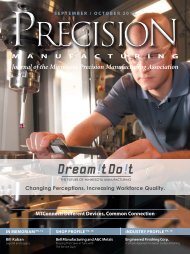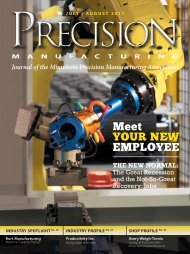July / August - Minnesota Precision Manufacturing Association
July / August - Minnesota Precision Manufacturing Association
July / August - Minnesota Precision Manufacturing Association
You also want an ePaper? Increase the reach of your titles
YUMPU automatically turns print PDFs into web optimized ePapers that Google loves.
David Brooks of the New York Times<br />
offered an interesting take recently<br />
on globalization and its effects on the<br />
economy, especially the manufacturing<br />
sector.<br />
While most people assume<br />
manufacturing is fleeing to Asia, U.S.<br />
manufacturing output has increased<br />
over recent decades. Since 1980, the U.S<br />
share of global manufacturing output<br />
has actually increased slightly, according<br />
to the Manufacturers Alliance/MAPI<br />
research firm.<br />
Thanks to new technology and<br />
innovation, manufacturing productivity<br />
in the United States has doubled in the<br />
past two decades. That’s not to say that<br />
we haven’t lost jobs. But consider the<br />
case of China, which shed 25 million<br />
manufacturing positions between 1994<br />
and 2004 – 10 times more than the<br />
United States, according to Brooks.<br />
Clearly, manufacturing still matters<br />
in the United States and shouldn’t be<br />
counted out.<br />
I bring this up because the <strong>Minnesota</strong><br />
Department of Employment and<br />
Economic Development (DEED)<br />
launched the Framework for Integrated<br />
Regional Strategies (FIRST) grant<br />
program last year to help the state remain<br />
competitive in the global economy.<br />
Among the beneficiaries of this effort<br />
will be manufacturers around the state.<br />
Before I get to that, however, some<br />
background is in order. FIRST was<br />
started after a series of listening sessions<br />
around the state. One of the things that<br />
<br />
<br />
<br />
<br />
<br />
<br />
<br />
we learned during those meetings was<br />
that regions often fail to marshal the<br />
collective brainpower and skills of their<br />
business executives, government officials,<br />
educators, workers, entrepreneurs and<br />
other community leaders.<br />
The idea behind FIRST is something<br />
I like to call sustainable collaboration.<br />
The program brings together local leaders<br />
to develop a strategy for economic<br />
development and growth in their regions.<br />
{ }<br />
<br />
<br />
<br />
<br />
<br />
To get the process started, DEED<br />
awarded grants this past winter, between<br />
the amounts of $45,000 and $50,000,<br />
to the top nine proposals in the state.<br />
Ideas came in from every corner of the<br />
state. A group in southwestern <strong>Minnesota</strong>,<br />
for example, plans to capitalize on that<br />
region’s strength in renewable energy<br />
– especially wind power and ethanol<br />
production – and other green resources<br />
and technology. One of the goals of a<br />
group in Stearns and Benton counties is<br />
to develop strategies for retaining that<br />
region’s pool of college graduates.<br />
Many of the FIRST proposals<br />
mentioned manufacturing, saying they<br />
wanted to develop strategies for keeping<br />
manufacturing competitive in their<br />
regions and for attracting skilled workers.<br />
One example was a proposal from the<br />
TwinWest Chamber of Commerce. The<br />
chamber, which represents 10 cities in the<br />
western suburbs (places like Plymouth,<br />
Golden Valley and St. Louis Park) was<br />
awarded a $45,000 FIRST grant in part<br />
for its plan to work with local precision<br />
manufacturers.<br />
<strong>Manufacturing</strong> remains an important<br />
sector in that part of the Twin Cities,<br />
accounting for 14.5 percent of the jobs,<br />
according to 2004 statistics. At the same<br />
time, 4,000 manufacturing jobs were lost<br />
in the region from 2002 to 2004.<br />
Given the job losses, it is ironic that<br />
many precision manufacturers in the<br />
western suburbs are frustrated because<br />
they can’t find enough qualified, skilled<br />
workers. The shortage is a threat to<br />
business growth and development in<br />
the region, according to the TwinWest<br />
Chamber.<br />
Fortunately, TwinWest has a solution.<br />
With the help of the FIRST grant,<br />
chamber executives are bringing together<br />
local manufacturers, educators and other<br />
community leaders to identify workforce<br />
deficiencies and to develop courses at<br />
local colleges to fill in the gaps. The<br />
process will include Hennepin Technical<br />
College and Dunwoody College of<br />
Technology and local manufacturers,<br />
such as Acrylic Design Associates in<br />
Plymouth, Intermet Die Cast in New<br />
Hope and Rotation Engineering &<br />
<strong>Manufacturing</strong> in Brooklyn Park.<br />
TwinWest hopes to have the “gaptraining”<br />
program ready to go by this<br />
fall or early next year.<br />
If I have learned anything in my<br />
many years of government service, it’s<br />
that there are always new and better ways<br />
of doing things. And for every problem,<br />
there is a solution. You just have to look<br />
hard enough.<br />
While the aim of the TwinWest effort<br />
and many of the other FIRST plans is to<br />
help local manufacturers, the overall goal<br />
is to keep <strong>Minnesota</strong> competitive globally.<br />
And that’s something that matters to<br />
everybody. PM


